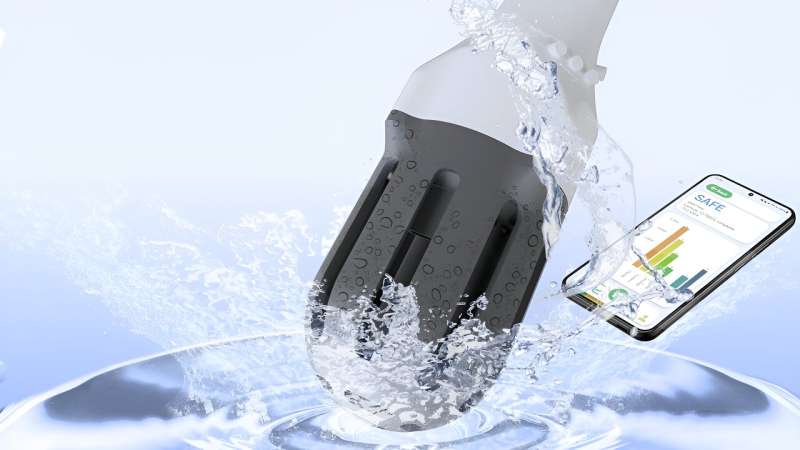Water quality monitor can help isolated communities track safe water sources
Published on by Water Network Research, Official research team of The Water Network in Technology
Water quality monitor can help isolated communities track safe water sources
by Will McManus, University of Bath

Team Bath Biodevices without Borders have created the OASIS water quality monitoring device. Credit: University of Bath
A portable water quality monitor created by a team of University of Bath students could help to rapidly detect and map safe water sources for communities around the world.
The OASIS device, created by Team Bath Biodevices without Borders, combines innovative water diagnostic and GPS technology to carry out rapid water quality analysis and plot the results to a global map.
When dipped in water, the device determines the quality and safety of the water by using a series of small electrochemical sensors to detect a range of contaminants, including chlorides, fluorides, and nitrates, as well as its pH level, temperature and turbidity (or clearness).
Results are then displayed on the device, and if a smartphone is connected, it can be uploaded and shared online.
The OASIS—short for On-site Aquatic Safety Inspection System—has been created by the student team, a Vertically Integrated Project (VIP) group. VIPs at Bath enable students from all year groups and across all University disciplines to collaborate with staff on long-term real-world issues.
The team recently drew on Bath's longstanding links with South Africa's Stellenbosch University to field test the OASIS and then explore how the device could be integrated into local communities to enable safe water consumption and monitoring.
Team Leader Alexz Farrall says the project aims to inform and give opportunities to those who may be unaware of contaminated water sources, while enabling students to build practical skills that can benefit global communities. He adds, "We are creating an innovative and genuinely useable device that, with some further development, could really make an impact on water safety and water scarcity.
"The OASIS uses affordable sensors to enable rapid detection of several chemical markers, doing analysis that would otherwise take hours in a lab. When you submerge the device in water, it can instantly give feedback on how clean and drinkable a water source is. Combined with GPS technology, it can empower users to be aware of how harmful or safe a water source is and share it with their community.
"This could work in areas where water is scarce, potentially contaminated, or where agricultural work can cause quite rapid changes to water quality. It can provide a form of immediate detection of risks, or for situations such as a cholera outbreak."
OASIS device
The OASIS device works by employing an array of electrochemical sensors. When these sensors come into contact with water, they initiate a series of electrochemical reactions, which are affected by the presence, concentration, and type of contaminants in the water. By analyzing the output of these reactions, the device can detect and quantify various clean water indicators.
While portable water sensors have previously been developed, the OASIS device's distinction lies in its affordability and innovative integration of technologies. By designing cheap and reliable sensors and making their project open-source, the team aims to work with NGOs to bring the device into full production and make it available in areas where they operate.
Dr. Despina Moschou, Senior Lecturer in Bath's Department of Electronic & Electrical Engineering and a member of the CBio Center for Bioengineering & Biomedical Technologies, is the team's academic director. Her research includes similar, compact testing equipment including "lab on chip" devices that can be used to detect a range of conditions including COVID-19.
Dr. Moschou says, "The device is sophisticated and addresses a major global problem in a simple and potentially very affordable way.
Taxonomy
- Monitors
- Water Monitoring
- Monitoring & Control
- Monitoring Devices
- Monitoring Technology
- Water Quality Monitoring Sensor